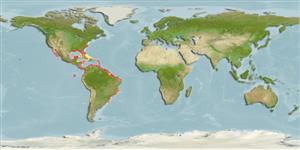Environment: milieu / climate zone / depth range / distribution range
Ökologie
seewasser; brackwasser demersal; ozeanodrom (Ref. 51243); tiefenbereich 0 - 100 m (Ref. 115829), usually 0 - 30 m (Ref. 5217). Subtropical; 11°C - 31°C (Ref. 47167); 40°N - 34°S, 117°W - 34°W
Eastern Central Pacific: Baja California to Peru (Ref. 9330); Northwestern Central Atlantic: Canada (Ref. 5951) to Chesapeake Bay, USA to the Antilles and southern Brazil.
Length at first maturity / Size / Gewicht / Alter
Maturity: Lm 8.5, range 8 - ? cm
Max length : 21.3 cm TL Männchen/unbestimmt; (Ref. 124487); common length : 15.0 cm TL Männchen/unbestimmt; (Ref. 5217); max. veröff. Gewicht: 64.40 g (Ref. 124487); max. veröff. Alter: 1.21 Jahre (Ref. 47359)
Rückenflossenstacheln (insgesamt): 0; Rückenflossenweichstrahlen (insgesamt): 73-87; Afterflossenstacheln 0; Afterflossenweichstrahlen: 57 - 68
Inhabits sandy and muddy bottoms (Ref. 9330). Common in estuaries (Ref. 9330). Feeds on big, benthic invertebrates and small fishes (Ref. 9330). Utilized fresh (Ref. 9330).
Oviparous (Ref. 101737). Distinct pairing (Ref. 205). Females produce numerous eggs in multiple spawnings during a prolonged spawning period (Ref. 101737).
Figueiredo, J.L. and N.A. Menezes, 2000. Manual de peixes marinhos do sudeste do Brasil. VI.Teleostei (5). Museu de Zoologia, Universidade de São Paulo. Brazil. 116 p. (Ref. 36453)
IUCN Rote Liste Status (Ref. 130435)
Bedrohung für Menschen
Harmless
Nutzung durch Menschen
Fischereien: weniger kommerziell
Mehr Information
ReferenzenAquakulturAquakultur ProfilZuchtlinienGenetikElectrophoresesVererbbarkeitKrankheitenVerarbeitungNutrientsMass conversion
Tools
Zusatzinformationen
Download XML
Internet Quellen
Estimates based on models
Preferred temperature (Ref.
123201): 21.1 - 28, mean 25.7 °C (based on 862 cells).
Phylogenetic diversity index (Ref.
82804): PD
50 = 0.5020 [Uniqueness, from 0.5 = low to 2.0 = high].
Bayesian length-weight: a=0.00832 (0.00661 - 0.01047), b=3.10 (3.03 - 3.17), in cm total length, based on LWR estimates for this species (Ref.
93245).
Trophic level (Ref.
69278): 3.5 ±0.1 se; based on diet studies.
Generation time: 2.4 ( na - na) years. Estimated as median ln(3)/K based on 2
growth studies.
Widerstandsfähigkeit (Ref.
120179): hoch, Verdopplung der Population dauert weniger als 15 Monate. (tmax=1.2; k >0.3).
Fishing Vulnerability (Ref.
59153): Low vulnerability (11 of 100).
Nutrients (Ref.
124155): Calcium = 191 [89, 438] mg/100g; Iron = 1.64 [0.75, 3.24] mg/100g; Protein = 17.7 [15.6, 19.8] %; Omega3 = 0.244 [0.120, 0.523] g/100g; Selenium = 36.6 [16.0, 86.1] μg/100g; VitaminA = 4.61 [1.15, 21.44] μg/100g; Zinc = 1.06 [0.66, 1.63] mg/100g (wet weight);
